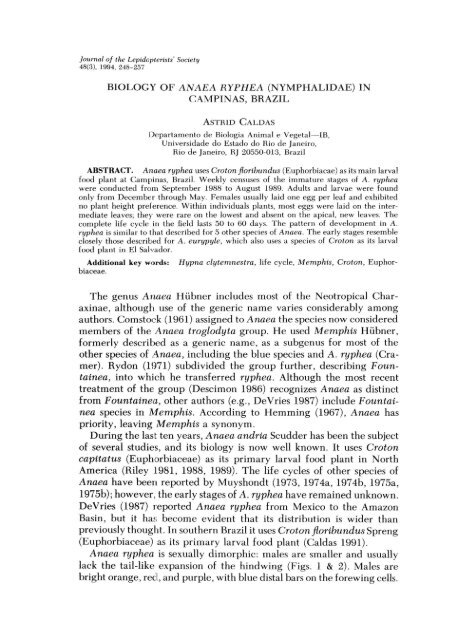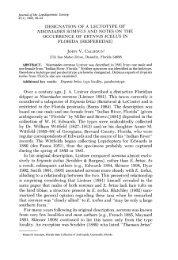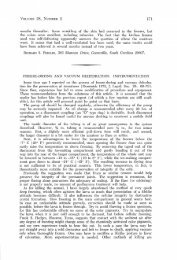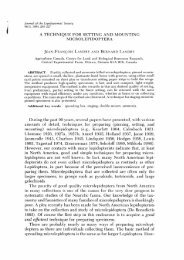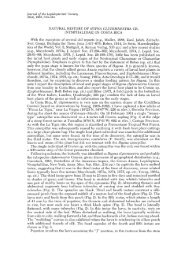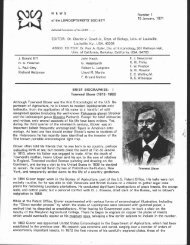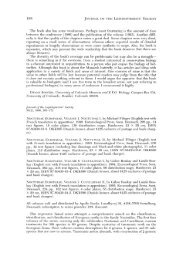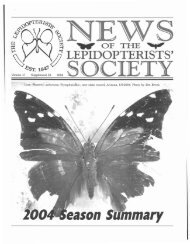Biology of Anaea ryphea - Yale University
Biology of Anaea ryphea - Yale University
Biology of Anaea ryphea - Yale University
Create successful ePaper yourself
Turn your PDF publications into a flip-book with our unique Google optimized e-Paper software.
Journal <strong>of</strong> the Lepidopterists' Society<br />
48(3), 1994, 248-257<br />
BIOLOGY OF ANAEA RYPHEA (NYMPHALIDAE) IN<br />
CAMPINAS, BRAZIL<br />
ASTRID CALDAS<br />
Dcpartamento de Biologia Animal e Vegetal-IB,<br />
Universidade do Estado do Rio de Janeiro,<br />
Rio de Janeiro, RJ 20550-013, Brazil<br />
ABSTRACT. <strong>Anaea</strong> <strong>ryphea</strong> uses Croton fioribundus (Euphorbiacae) as its main larval<br />
food plant at Campinas, Brazil. Weekly censuses <strong>of</strong> the immature stages <strong>of</strong> A. <strong>ryphea</strong><br />
were conducted from September 1988 to August 1989. Adults and larvae were found<br />
only from December through May. Females usually laid one egg per leaf and exhibited<br />
no plant height preference. Within individuals plants, most eggs were laid on the intermediate<br />
leaves; they were rare on the lowest and absent on the apical, new leaves. The<br />
complete life cycle in the field lasts 50 to 60 days. The pattern <strong>of</strong> devclopment in A.<br />
<strong>ryphea</strong> is similar to that described for 5 other species <strong>of</strong> <strong>Anaea</strong>. The early stages resemble<br />
closely those described for A. eurypyle, which also uses a species <strong>of</strong> Croton as its larval<br />
food plant in El Salvador.<br />
Hypna clytemnestra, life cycle, Memphis, Croton, Euphor<br />
Additional key words:<br />
biaceae.<br />
The genus <strong>Anaea</strong> Hubner includes most <strong>of</strong> the Neotropical Charaxinae,<br />
although use <strong>of</strong> the generic name varies considerably among<br />
authors. Comstock (1961) assigned to <strong>Anaea</strong> the species now considered<br />
members <strong>of</strong> the <strong>Anaea</strong> troglodyta group. He used Memphis Hubner,<br />
formerly described as a generic name, as a subgenus for most <strong>of</strong> the<br />
other species <strong>of</strong> <strong>Anaea</strong>, including the blue species and A. <strong>ryphea</strong> (Cramer).<br />
Rydon (1971) subdivided the group further, describing Fountainea,<br />
into which he transferred <strong>ryphea</strong>. Although the most recent<br />
treatment <strong>of</strong> the group (Descimon 1986) recognizes <strong>Anaea</strong> as distinct<br />
from Fountainea, other authors (e.g., DeVries 1987) include Fountainea<br />
species in Memphis. According to Hemming (1967), <strong>Anaea</strong> has<br />
priority, leaving Memphis a synonym.<br />
During the last ten years, <strong>Anaea</strong> andria Scudder has been the subject<br />
<strong>of</strong> several studies, and its biology is now well known. It uses Croton<br />
capitatus (Euphorbiaceae) as its primary larval food plant in North<br />
America (Riley 1981, 1988, 1989). The life cycles <strong>of</strong> other species <strong>of</strong><br />
<strong>Anaea</strong> have been reported by Muyshondt (1973, 1974a, 1974b, 1975a,<br />
1975b); however, the early stages <strong>of</strong> A. <strong>ryphea</strong> have remained unknown.<br />
DeVries (1987) reported <strong>Anaea</strong> <strong>ryphea</strong> from Mexico to the Amazon<br />
Basin, but it has become evident that its distribution is wider than<br />
previously thought. In southern Brazil it uses Croton floribundus Spreng<br />
(Euphorbiaceae) as its primary larval food plant (Caldas 1991).<br />
<strong>Anaea</strong> <strong>ryphea</strong> is sexually dimorphic: males are smaller and usually<br />
lack the tail-like expansion <strong>of</strong> the hindwing (Figs. 1 & 2). Males are<br />
bright orange, red, and purple, with blue distal bars on the forewing cells.
VOLUME 48, NUMBER 3 249<br />
FIGS. 1-2. Ventral (left) and dorsal (right) views <strong>of</strong> adult <strong>Anaea</strong> <strong>ryphea</strong>. I, male. 2,<br />
female.<br />
Females always have the hind wing expansion ("tail"), dark brown bars<br />
on the forewing cells, and yellow and orange as the dominant colors<br />
on both wings. The species is found in tropical and subtropical forests,<br />
where it can he seen in rapid flight or perched on urine, feces, and<br />
rotten fruits. Herein I describe 'he life cycle <strong>of</strong> A. <strong>ryphea</strong> from southeastern<br />
Brazil.<br />
STUDY SITE AND METHODS<br />
This study was conducted in the Santa Genebra Reserve, Campinas,<br />
Sao Paulo, Brazil (22,054'S, 47°05'W, elevation 650 m). The reserve<br />
includes 2,517,759 m" <strong>of</strong> disturbed subtropical semi-deciduous forest.<br />
Mean monthly temperature varies from 18°C to 29°C, with daily fluctuations<br />
<strong>of</strong> as much as 20°C from July to September. The dry season<br />
lasts from May through September. The rainy season may start with<br />
light rainfall or with heavy "summer storms." Frosts are rare, but may<br />
occur from July to September. Although the study was conducted from<br />
September 1988 throUlgh April 1991, the data presented here refer only<br />
to the first wet season, from December 1988 to May 1989.<br />
I visited the reserve once a week from September 1988 through<br />
January 1989, then twice a week until mid-February. From then on,<br />
visits were more frequent, increasing to every other day until late April<br />
1989, when they became weekly again.<br />
Croton fioribundus is a lactescent plant that can be either a small<br />
shrub or a tall tree, depending on its age and environmental conditions.<br />
The smallest plant found was only 20 cm tall, while the largest was<br />
more than 4 m. The leaves are alternate, stipulate, and grayish green.
250 JOURNAL OF THE LEPIDOPTERISTS' SOCIETY<br />
Leaf size depends on plant height: lO cm long on plants up to 2 m tall<br />
and 20 cm long on taller plants. The inflorescences are monoecious,<br />
with male flowers terminal. At the study site, flowers were seen during<br />
December. Other species <strong>of</strong> Croton are recorded as food plants for<br />
species <strong>of</strong> Nymphalidae (DeVries 1987) and Riodinidae (DeVries 1988).<br />
Croton floribundus is common in the Santa Genebra Reserve, in both<br />
sunny and shaded areas, as solitary individuals or in patches. It grows<br />
mostly along the edges <strong>of</strong> trails and is rare in the middle <strong>of</strong> the forest.<br />
The soil along the trails is mostly clay, and during the dry season the<br />
plants seem to resist desiccation. From Mayan, plants begin to dry out,<br />
sometimes being reduced to no more than a woody stem that puts out<br />
new leaves the next wet season. During the rainy season, the soil maintains<br />
a high water content. Along the reserve's central road (1,160 m<br />
long), I found 186 plants. All were mapped and marked for use in this<br />
study.<br />
During each visit I checked all leaves for larvae on the 186 marked<br />
plants. Eggs were difficult to detect, so exact numbers were not known<br />
until the following season. Twenty eggs were collected and taken into<br />
the laboratory. These eggs were the source <strong>of</strong> hatching time observations.<br />
In the field, each leaf with a larva was individually numbered<br />
because larvae stay on the same leaf most <strong>of</strong> the time. All larvae were<br />
measured and identified as to instar. Their height from the ground and<br />
the general aspect <strong>of</strong> the leaf were noted. With this methodology I was<br />
able to (1) follow the growth <strong>of</strong> every individual, (2) determine the<br />
duration <strong>of</strong> each instar in the field, and (3) assess mortality for each<br />
instar.<br />
RESUL TS AND DISCUSSION<br />
Oviposition<br />
A naea <strong>ryphea</strong> eggs are laid singly and usually one per leaf, in the<br />
central third <strong>of</strong> the under surface. Rarely, two or three eggs are laid.<br />
A similar oviposition pattern was described by Ramos (1984) for <strong>Anaea</strong><br />
troglodyta borinquenalis and by Muyshondt (1975b) for <strong>Anaea</strong> (Memphis)<br />
pithyusa. Females fly around the plant, inspecting leaves quickly<br />
before ovipositing. I could not tell whether eggs laid on the same leaf<br />
came from the same female. Placing one egg per leaf could eliminate<br />
competition during the early instars, when larvae have restricted movement.<br />
In Colon Province, Republic <strong>of</strong> Panama, 1991, while studying<br />
the same species, I saw females placing more than one egg on the same<br />
leaf <strong>of</strong> Croton billbergianus, although not sequentially. In each <strong>of</strong> the<br />
three cases observed, the female flew from one leaf to another, ovi-
VOLUME 48, NUMBER ;) 251<br />
positing on acceptablle leaves, eventually returning to oviposit on a leaf<br />
she already had used.<br />
There was no plant height preference for oviposition among the 186<br />
marked plants. All instars were found between 15 cm and 2 m above<br />
the ground, on short or tall plants. I did not include plants taller than<br />
2 m in this study owing to the difficulty in reaching high leaves, but<br />
even on those, I could see active larvae when they were present. Within<br />
the same plant, though, larvae were found mostly on intermediate<br />
leaves, never on the apical ones, and rarely on the lower (older) ones.<br />
This distribution seems to be related to the age <strong>of</strong> the leaves, not to<br />
their height from the ground.<br />
Development and Behavior<br />
After eclosion larvae eat the egg shell and move toward the apex <strong>of</strong><br />
the leaf where they begin to feed on both sides <strong>of</strong> the midvein, which<br />
when exposed becomes their resting place. This behavior, common in<br />
Nymphalidae, also is considered common for other <strong>Anaea</strong> species (Muyshondt<br />
] 974a). Ramos (1984) reported that larvae <strong>of</strong> A. troglodyta<br />
borinquenalis build a perching place from the tip instead <strong>of</strong> exposing<br />
the midvein first . \Vhen not feeding, A. <strong>ryphea</strong> larvae remain on this<br />
vein facing the apex, grasping the vein with both thoracic and abdominal<br />
legs. It is rare to see a larva start feeding on another part <strong>of</strong> the<br />
leaf, but when this happens, a lateral vein is chosen and used in the<br />
same manner. In either case, an individual may add fecula ("frass<br />
chain") to the vein, perhaps to strengthen it. Fecula is added mostly<br />
when the vein is thin, whether it is a lateral or central one. It also may<br />
be used to extend the vein beyond its natural length.<br />
From the third instar on, A. <strong>ryphea</strong> larvae may roll the leaf to form<br />
a tubular shelter, holding it closed with silk, although this behavior<br />
usually is observed from fourth instar on. They begin by laying silk<br />
over the entire area <strong>of</strong> leaf that is to be rolled. As they add to and<br />
strengthen the threads, the leaf begins to curve and roll itself into a<br />
tube. Normally, the apical portion <strong>of</strong> the leaf is used to construct the<br />
shelter. If the leaf is damaged by some external event such as bird<br />
attack or herbivore~, the larva may move to another leaf. Change <strong>of</strong><br />
leaf does not necessarily follow any special rule, and I have observed<br />
larvae moving to new and old leaves, above or below the original one.<br />
The tube is open at both ends, but the opening that faces the base <strong>of</strong><br />
the leaf is the larger <strong>of</strong> the two and is used by the larvae as the entrance<br />
and exit. The smaller opening is used to dispose <strong>of</strong> fecula. In order to<br />
enter the tube, the larva approaches close to opening, then makes a<br />
u-turn and backs into the shelter.<br />
I did not measure leaf consumption, but observations show that larvae
252 JOURNAL OF THE LEPIDOPTERISTS' SOCIETY<br />
usually feed on the same leaf through the third instar, reducing it to<br />
one-half or one-third its original size. From third instar on, feeding<br />
increases noticeably. Larvae can move to another leaf and build a new<br />
tube if the first leaf is consumed before pupation, but that rarely was<br />
seen. More commonly they visit another leaf just to eat, then return to<br />
the old leaf where the shelter is kept (they never eat the roll). Feeding<br />
takes place mainly from dusk to dark, as do molting and pupation.<br />
When not eating, larvae remain on the mid vein or inside the tube.<br />
During the last instar, the larva abandons the plant and searches for a<br />
suitable place to pupate.<br />
Early Stages<br />
Egg (Fig. 3). Approximately 1 mm in diameter (n = 10). Spherical, with small depression<br />
on top (micropyle end), greenish white, with no conspicuous sculpturing. Duration 5-6<br />
days.<br />
First Instar (Fig. 5). Length 1.5-8.0 mm (n = 1161). Head brown with dark brown<br />
spots, lighter near foramen; epicranial suture complete, well marked. Body eruciform,<br />
hazel, darker posteriorly. Duration approximately 6 days (n = 278).<br />
Second Instar (Fig. 4). Length 5-14 mm (n = 598). Head light brown with three dark<br />
stripes on each side; frons with central dark stripe; pair <strong>of</strong> small scoli (each with two<br />
setae) on vertex, scattered chalazae restricted to sides <strong>of</strong> head. Body pale greenish brown<br />
with pale spots throughout, slightly enlarged on second abdominal segment. Duration<br />
approximately 6 days (n = 155).<br />
Third Instar (Fig. 6). Length 8-20 mm (n = 308). H ead similar to that <strong>of</strong> second instar,<br />
but with a series <strong>of</strong> dark spots between the three dark stripes <strong>of</strong> the epicranium, also<br />
some dark dots around the foramen; scoli larger than on second instar, with more chalazae.<br />
Body green, except second, fifth, and seventh abdominal tergi, which are brown; second<br />
abdominal segment enlarged, forming a small dorsal hump. Duration approximately 7<br />
days (n = 105).<br />
Fourth Instar (Fig. '7). Length 14-24 mm (n = 30l). Head similar to third instar, with<br />
dark stripes more pronounced, scoli resembling antlers, and chalazae all over head. Body<br />
brownish green, with dark brown subdorsal stripes following second and third thoracic<br />
segments, turning dorsal and joining to form a broad dorsal band across the first and<br />
second abdominal segments; fourth through tenth abdominal segments also with dark<br />
brown subdorsal stripe; third abdominal segment entirely green. Hump on second abdominal<br />
segment more conspicuous than in previous instar. Duration approximately 7<br />
days (n = 83).<br />
Fifth Instar (Fig. 8). Length 20-28 mm (n = 273). Remarkably distinct from previous<br />
instars. Head green; scoli large, Y -shaped; chalazae present in greater density. Body bright<br />
green, with black dots on dorsal and lateral surfaces <strong>of</strong> all segments; second, fifth, and<br />
seventh abdominal segments with reddish hazel subdorsal stripes. Duration 8-15 days (n<br />
= 45).<br />
Pre-pupa (Fig. 9). Green, curled horizontally rather than vertically as in other nymphalids,<br />
and appressed to its support. Duration 2 days (n = 12).<br />
Pupa (Fig. 10). Green, naked; dark cremaster attached to white silken pad. Duration<br />
approximately 12 days (n = 12).<br />
The duration <strong>of</strong> the early stages in the field requires 50-60 days,<br />
accounting for individual variation. The pattern <strong>of</strong> development <strong>of</strong><br />
<strong>Anaea</strong> <strong>ryphea</strong> is sjimilar to that described for <strong>Anaea</strong> (Zaretis) itys on
VOLUME 48, NUMBER ~ , 253<br />
FIGS. 3-6. Early stages <strong>of</strong> <strong>Anaea</strong> <strong>ryphea</strong>. 3, Egg on Croton billbergianus leaf. 4,<br />
Second instar larva with frass chain. 5, First instar. 6, Third instar larva.
254 JOURNAL OF THE LEPIDOPTERISTS' SOCIETY
VOLUME 48, NUMBER 3 255<br />
Casearia nitida (L.) Jacq. (Flacouidaceae) (Muyshondt 1973); for <strong>Anaea</strong><br />
(Consul) fabius Doubleday on Piper tuberculatum Jacquin, P. auritum<br />
H.B.K., and P. umbel/atum L. (Piperaceae) (Muyshondt 1974a); and<br />
for <strong>Anaea</strong> (Memphis) pithyusa on Croton refiexifolius H.B.K. and C.<br />
niveus Jacquin (Euphorbiaceae) (Muyshondt 1975b), all <strong>of</strong> which were<br />
reared in the laboratory from field collected eggs. The eggs <strong>of</strong> the four<br />
species (including A. ri'Jphea) are similar, and instars show minor variations.<br />
Duration <strong>of</strong> development is slightly shorter in A. (Zaretis) itys<br />
and A. (Memphis) pithyusa, and longer in A. (Consul) fabius. It is<br />
likely that the differences observed in the laboratory also would be<br />
present under field conditions. <strong>Anaea</strong> (Zaretis) itys differs from the<br />
others in that it does not build a leaf roll. Instead, it remains at the tip<br />
<strong>of</strong> the leaf until the pre-pupal stage. In all four species, the pre-pupae<br />
curl horizontally instea.d <strong>of</strong> vertically as in other nymphalids, and hang<br />
straight down only after pupation. Ramos (1984) described the prepupa<br />
<strong>of</strong> A. troglodyta horquenalis as different from these four speciesit<br />
is the only one that curls vertically.<br />
In addition to the species discussed above, the early stages <strong>of</strong> <strong>Anaea</strong><br />
eurypyle confusa Halll (Muyshondt 1974b) also are similar to those <strong>of</strong><br />
A. <strong>ryphea</strong>. Both use species <strong>of</strong> Croton, and the eggs and larvae are<br />
similar. There are slight differences in head sculpturing and body color<br />
<strong>of</strong> the larvae, and in color and shape <strong>of</strong> the adult's wings.<br />
The life history information presented above on A. <strong>ryphea</strong> was collected<br />
during extensive field observations. The animals in my study<br />
were allowed to remain under natural conditions in contrast to the<br />
laboratory conditions <strong>of</strong> the other studies cited above. This is one <strong>of</strong><br />
the reasons for the dramatic decrease in numbers <strong>of</strong> observations from<br />
one instar to the next, which more accurately reflects the fate <strong>of</strong> natural<br />
populations in the field. Only the pre-pupa and pupa stages had to be<br />
observed in the laboratory because fifth instar larvae would have been<br />
lost when they left their plants to pupate. No pupae were ever found<br />
on or near C. fioribundus in the field.<br />
Variations in rearing conditions can affect the ultimate form <strong>of</strong> the<br />
adult in species with ~;easonal forms. This was studied by Riley (1981,<br />
1989) in A . andria. So far, no seasonal variation has been observed in<br />
A . <strong>ryphea</strong> in the field, although males exhibit considerable variation in<br />
the color and shape <strong>of</strong> the wings.<br />
FIGS. 7-10. Early stages <strong>of</strong> <strong>Anaea</strong> <strong>ryphea</strong>. 7, Fourth instar larva. 8, Fifth instar larva.<br />
9, Pre-pupa. 10, Pupa.
256 JOURNAL OF THE LEPIDOPTERISTS' SOCIETY<br />
Herbivory and Associated Fauna<br />
<strong>Anaea</strong> <strong>ryphea</strong> larvae seldom were seen eating the lowest leaves (old<br />
and damaged), and they never fed on apical leaves. Other herbivores<br />
also were observed on the intermediate portions <strong>of</strong> the plants. One<br />
species <strong>of</strong> cricket (Orthoptera: Gryllidae) ate patches from the leaves<br />
giving them the aspect <strong>of</strong> lace; one species <strong>of</strong> beetle (Coleoptera: Chrysomelidae)<br />
was observed eating the petiole; and one species <strong>of</strong> true bug<br />
(Hemiptera) appeared to be feeding on the petiole. Larvae <strong>of</strong> Hypna<br />
clytemnestra Cramer (Nymphalidae) are common on Croton fioribundus,<br />
frequently outcompeting A. <strong>ryphea</strong> with their ability to defoliate<br />
small plants. There also is a species <strong>of</strong> aphid (Homoptera: Aphidae)<br />
that uses C. fioYibundus. Individuals aggregate on the undersides <strong>of</strong><br />
leaves, and as a result, the upperside becomes dotted with white spots.<br />
A leaf-mining microlepidopteran was taken to the laboratory for<br />
rearing, but all individuals died before pupation; hence, identification<br />
was not possible. The mine follows the edge <strong>of</strong> the leaf and when that<br />
area is used, the larva turns toward the central part <strong>of</strong> the leaf following<br />
the central vein, never crossing it. Pheidole ants (Hymenoptera: Formicidae)<br />
wee seen predating upon eggs <strong>of</strong> A. <strong>ryphea</strong> (n = 10), but were<br />
never observed imteracting with the larvae.<br />
In addition to Ithose species mentioned above, a variety <strong>of</strong> other insects<br />
and spiders were seen regularly on C. fioribundus, but not feeding on<br />
it. Some individuals <strong>of</strong> C. fioribundus produce globs <strong>of</strong> a translucent<br />
gum, usually close to the apical leaves, that perhaps serve as a mechanical<br />
defense against some herbivores.<br />
The practice <strong>of</strong> leaving the midvein and secondary veins intact, as<br />
exhibited by A. <strong>ryphea</strong>, appears to represent a feeding strategy described<br />
for other species <strong>of</strong> Lepidoptera (Compton 1987), and differs<br />
from the strategy <strong>of</strong> those species that cut the mid vein to prevent toxins<br />
from getting to the portion <strong>of</strong> the leaf to be consumed. The former<br />
strategy allows tile larvae <strong>of</strong> A. <strong>ryphea</strong> to avoid contact with the latex<br />
that C. fioribundus produces, which suggests that they are incapable<br />
<strong>of</strong> detoxifying or storing high concentrations <strong>of</strong> this substance. Hypna<br />
clytemnestra and the leaf-mining microlepidoptera reported from C.<br />
fioribundus also avoid the midvein, although the former may eat secondary<br />
veins. Thiis type <strong>of</strong> behavior has been interpreted as an important<br />
step toward a disguise for these larvae (Hingston 1932) which add pieces<br />
<strong>of</strong> leaves and fecula to the midvein to improve the resemblance <strong>of</strong> the<br />
substrate to their body (Fig. 4) . Such a behavior may reduce the level<br />
<strong>of</strong> predation.
VOLUME 48, NUMBER 3 257<br />
ACKNOWLEDGMENTS<br />
This work was supported by grants from F AEP jUNICAMP and CAPES, Brazil. I thank<br />
Woodruff W. Benson for teaching me the method ology and for his support <strong>of</strong> my ideas<br />
during the project; Keith S. Brown, Jr., for invaluable advice on Lepidoptera; and the<br />
Smithsonian Tropical Research Institute, Panama, for the use <strong>of</strong> facilities during the<br />
preparation <strong>of</strong> this manuscript and studies <strong>of</strong> local populations <strong>of</strong> A. <strong>ryphea</strong>. I am especially<br />
indebted to Carl C. Hansen for the wonderful photographs and to Annette Aiello, who<br />
exhaustively revised the manuscript with me.<br />
LITERA TURE CITED<br />
CALDAS, A. 1991. A population <strong>of</strong> <strong>Anaea</strong> <strong>ryphea</strong> (Nymphalidae) and its larval foodplant<br />
at Campinas, Brazil. J. Lepid. Soc. 45:68.<br />
COMPTON, S. G. 1987. Aganais speciosa and Danaus chrysippus (Lepidoptera) sabotage<br />
the latex defenses <strong>of</strong> their host plants. Ecol. Entomol. 12: 115-118.<br />
COMSTOCK, W. P. 1961. Butterflies <strong>of</strong> the American tropics. The genus <strong>Anaea</strong>, Lepidoptera,<br />
Nymphalidae. American Museum <strong>of</strong> Natural History, New York. 214 pp.<br />
DESCIMON, H. 1986. The evolution <strong>of</strong> coloration in Neotropical Charaxinae: Adaptive<br />
strategies and cladogenesis (Lepidoptera, Rhopalocera). Bull. Soc. Zoo I. Fr. III :261-<br />
296.<br />
DEVRIES, P. J. 1987. The butterflies <strong>of</strong> Costa Rica and their natural history. Princeton<br />
<strong>University</strong> Press, New Jersey. 327 pp.<br />
1988. The larval ant organs <strong>of</strong> Thisbe irenea (Lepidoptera: Riodinidae) and<br />
their effects upon attending ants. Zool. J. Linn. Soc. 94:379-393.<br />
HEMMING, F. 1967. The generic names <strong>of</strong> the butterflies and their type-species (Lepidoptera:<br />
Rhopalocera). Bull. Brit. Mus. (Nat. Hist.) Entomol. Suppl. 9.<br />
HINGSTON, R. W. G. 19~12. A naturalist in the Guiana forest. Longmans, Green & Co. ,<br />
New York.<br />
MUYSHONDT, A. 1973. Notes on the life cycle and natural history <strong>of</strong> butterflies <strong>of</strong> EI<br />
Salvador. II. <strong>Anaea</strong> (Zaretis) itys (Nymphalidae). J Lepid. Soc. 27:294- 302.<br />
1974a. Notes on the life cycle and natural history <strong>of</strong> butterflies <strong>of</strong> EI Salvador.<br />
III. <strong>Anaea</strong> (Consul) fabius (Nymphalidae). J. Lepid. Soc. 28:81-89.<br />
1974b. Notes on the life cycle and natural history <strong>of</strong> butterflies <strong>of</strong> EI Salvador<br />
III. <strong>Anaea</strong> (Memphi;;) eurypyle confusa (Nymphalidae). J. Lepid. Soc. 28:306-314.<br />
---. 1975a. Notes on the life cycle and natural history <strong>of</strong> butterflies <strong>of</strong> EI Salvador.<br />
III. <strong>Anaea</strong> (Memphis) morvus boisduvali (Nymphalidae). J. Lepid. Soc. 29:32-39.<br />
1975b. Notes on the life cycle and natural history <strong>of</strong> butterflies <strong>of</strong> EI Salvador.<br />
III. <strong>Anaea</strong> (Memphis) pithyusa (Nymphalidae). J. Lepid. Soc. 29:168-176.<br />
RAMOS, S. J. 1984. Notcs on the life cycle and biology <strong>of</strong> <strong>Anaea</strong> troglodyta borinquenalis<br />
(Lepidoptera: Apaturidae). Carib. J. Sci. 20:19- 24.<br />
RILEY, T. J. 1981. Effect <strong>of</strong> long and short day photoperiod on the seasonal dimorphism<br />
<strong>of</strong> <strong>Anaea</strong> andria (Nymphalidae) from central Missouri. J. Lepid. Soc. 34:330-337.<br />
1988. Effect <strong>of</strong> larval photoperiod on mating and reproductive diapause in<br />
seasonal forms <strong>of</strong> <strong>Anaea</strong> andria (Nymphalidae). J. Lepid. Soc. 42:263-268.<br />
---. 1989. Effect <strong>of</strong> larval photoperiod on incidence <strong>of</strong> adult seasonal forms in <strong>Anaea</strong><br />
andria (Lepidoptera: Nymphalidae). J. Kansas Entomol. Soc. 61:224-227.<br />
RYDON, A. H. B. 1971. The systematics <strong>of</strong> the Charaxidae (Lepidoptera: Nymphalidae).<br />
Entomol. Rec. J. VaL 83:339- 341.<br />
Received for publication 25 June 1993; revised and accepted 12 March 1994.


